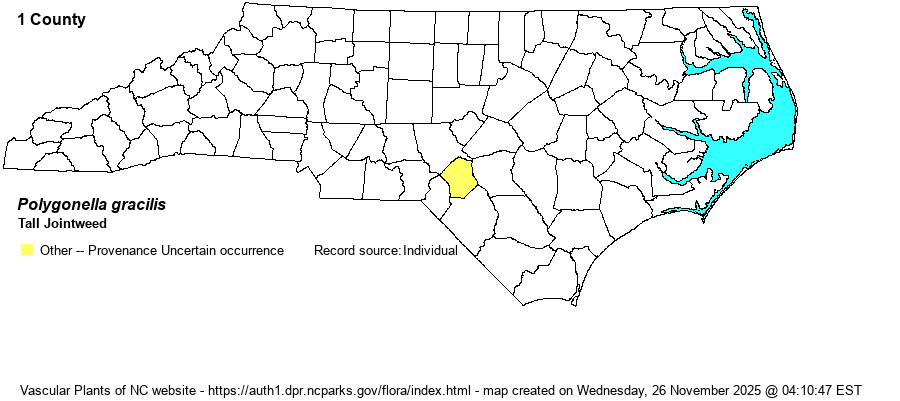| Author | (Nuttall) Meisner | |
| Distribution | Known only from two records at Fort Bragg in Hoke County -- photos and a specimen (not yet deposited in an herbarium) by Alicia Jackson in 2022, and a single sight record (no specimen?) made by the TNC Rare Species team from Normandy Drop Zone on Fort Bragg in Hoke County. The long distance disjunction from the nearest population (Jasper County, SC) suggests that the NC records are adventive or accidentally introduced and therefore perhaps not native -- even though Weakley (2022) considers it as native in NC.
Southern SC to southern FL, west to southern MS; disjunct to southern NC. | |
| Abundance | Very rare, at drop zones at Fort Bragg only. The NCNHP gives it a State Rank of SU (Undetermined), with the State Status of W4 (perhaps not native). The website editors also feel it is likely not native, but prefer the use of SE? (perhaps exotic) rather than the vague SU. | |
| Habitat | Sandhills and other sandy soils. | |
| Phenology | Flowers late August-October; fruits October-November. | |
| Identification | This species grows to 2-2.5 feet tall, quite slender and erect. It has small white flowers in a narrow raceme, and is very similar to P. articulata, also branched mostly well above the base; however, that species is a mid-Atlantic one ranging south barely to the northeastern edge of the state. | |
| Taxonomic Comments | A few recent authors have noted the genetic similarity of Polygonella to Polygonum and have lumped the two. Because the two can be easily told apart in the field, taxon editors, including Weakley (2018), prefer to recognize both genera. | |
| Other Common Name(s) | Wireweed | |
| State Rank | SU [SE?] | |
| Global Rank | G4G5 | |
| State Status | W4 | |
| US Status | | |
| USACE-agcp | | |
| USACE-emp | | |

